Validation of supply chain data structures
a data structure and supply chain technology, applied in the field of computer applications, can solve problems such as faulty output, incorrect or poor quality input data, and very sensitive data quality in the supply chain planning system
- Summary
- Abstract
- Description
- Claims
- Application Information
AI Technical Summary
Benefits of technology
Problems solved by technology
Method used
Image
Examples
Embodiment Construction
[0021]Material requirements planning (MRP) solutions operate on large input data sets which include but are not limited to demand, supply, structure, and parametric information, where the structure input includes both bill of material (BOM) data and cross business entity, also known as interplant, relationships. MRP execution transforms the demand input into material requirements by applying the structure and supply inputs to the demand. While demand and supply shifts are primary drivers of changes in exploded component demand (based on BOM items per product and product demand), shifts in BOM and interplant data can have profound impacts on the MRP result. Demand and supply shifts are easy to identify and quantify. But since input sets are typically large (e.g., hundreds of thousands of records) and attributes which tag records as members of a part or relationship transition set are lacking, structure changes are difficult to find. Once found the linkage between a structure change a...
PUM
 Login to View More
Login to View More Abstract
Description
Claims
Application Information
 Login to View More
Login to View More - R&D
- Intellectual Property
- Life Sciences
- Materials
- Tech Scout
- Unparalleled Data Quality
- Higher Quality Content
- 60% Fewer Hallucinations
Browse by: Latest US Patents, China's latest patents, Technical Efficacy Thesaurus, Application Domain, Technology Topic, Popular Technical Reports.
© 2025 PatSnap. All rights reserved.Legal|Privacy policy|Modern Slavery Act Transparency Statement|Sitemap|About US| Contact US: help@patsnap.com



